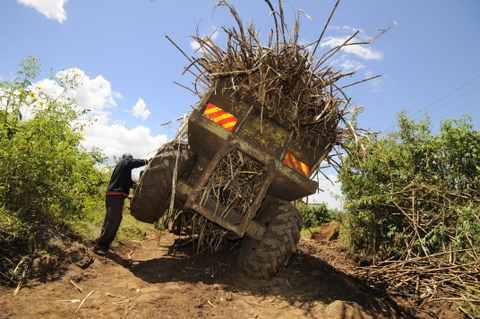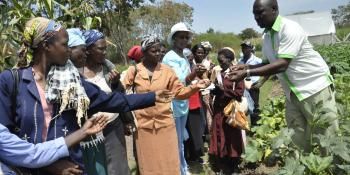Adaptation or Development?

Guest post by Chase Sova (CIAT).
When we think of climate change adaptation in agriculture the first thing that comes to mind is improved crop varieties. Water harvesting and irrigation schemes may also be high on our list. Perhaps too is crop diversification. But on a recent trip to western Kenya, one agricultural community reminded us that sometimes the interventions that can most improve the adaptive capacities of small-scale farmers may not occur on or even near the farm.
Othidhe is a small agricultural community in Kenya’s Nyando Basin (click for map) set against the backdrop of the eastern branch of Africa’s Great Rift Valley. A settlement community, Othidhe was founded shortly after Kenya’s independence in 1963 and is the product of a targeted land reform program. The settlers in Othidhe received ten hectares of land from the government with the explicit purpose of developing the region in to a sugarcane production zone. Today, vast fields of sugarcane dominate the treeless landscape (clear-cut over several decades to expand cane production) disturbed only by the smoky stacks of the Muhoroni Sugar Factory.
Researchers from the International Center for Tropical Agriculture (CIAT), the CGIAR Climate Program (CCAFS) and Oxford University recently spent several weeks in Othidhe gathering perspectives on climate change risk and developing achievable action plans to improve the community’s resilience and adaptive capacity. Topping the list of actionable steps was a community health clinic and improved rural roads. The rationale; sick farmers can’t work, and flooded, destroyed roads can’t be travelled.
Clinics, roads and… climate change adaptation?
While many villages throughout the Nyando basin are facing increasing water stress, Othidhe is spared by the Mtwala River, a permanent source of water that winds through the village. A tributary, the Othidhe stream, provides an additional source of water during Nyando’s rainy season. But the water resources in the village can be both a blessing and a curse. Othidhe’s year-round water supply supports vector-borne diseases that only intensify when the rains come. Kenya’s Nyando district already ranks among the country’s highest in terms of water-borne disease prevalence. It’s no surprise, then, that Othidhe’s farmers are plagued by seemingly endless bouts of Malaria, TB and Cholera. The nearest health dispensary is located in the town of Muhoroni, four kilometers from Othidhe’s center, and eight kilometers when travelling on the only passable road.
Rainy season floods are largely responsible for Othidhe’s poor road infrastructure, but so too are the tractor-trailers that the Muhoroni Sugar Factory uses to harvest cane — 10 tons at a time. Together, these two factors have left the community’s roads badly washed out and rutted, and largely impassible with mechanized transportation. The sad irony is that the harvesting of sugarcane, and consequently the farmer’s livelihoods, depends highly on the Muhoroni Sugar trucks’ ability to arrive at the harvest site on those same roads. Sugarcane is a long duration crop, so if the trucks cannot reach the mature cane it represents a 12-18 month loss for the producer and the company.

But the poor road conditions do more than limit the transport of sugarcane; they are a significant risk to Othidhe’s food security. The community allocates over 80% of their land to cane production, leaving little space for their own subsistence activities. With frequent food shortages, many trips to the nearest market in Muhoroni are needed to purchase or sell produce (what little is not consumed). These trips are made taking the long, 8km route to town on roads that are only passable when there is no rain.
See the role that roads played in Norman Borlaug’s Green Revolution
Adaptation vs. development
Othidhe’s story lends itself to a much broader discussion on the sometimes tenuous distinction between adaptation and development. Can health clinics and rural roads qualify as climate change adaptation if investments in both will undoubtedly increase resilience and adaptive capacity? Especially so in agricultural, where an incredible number of off-farm factors contribute to production and food security, the line where business-as-usual development ends and climate change adaptation begins can be unclear. But is that such a bad thing?
For years, the UNFCCC has warned that countries need to take concrete action towards adaptation to climate change, but that those actions should be integrated in to existing national and sectoral development plans. While that is a worthy objective, it is not always aligned with the strong incentive to view adaptation and development as two distinct themes. Climate change adaptation funds, the ‘big dividers’, have a tendency to force artificial distinctions between the two as conditions for lending. As delivery mechanisms for these fledging climate funds are developed, it will pay to acknowledge the synergies, although often subtle, between adaptation and development.
Finally, as climate change researchers, in our earnest efforts to help communities avoid climate risks, we can easily fall victim to tunnel vision, losing sight of the inherent connections between agricultural adaptation and the host of other factors that contribute to farmers’ livelihoods and food security. Othidhe village reminds us that for small-scale producers the decision making process is not drawn along the lines of ‘adaptation’, ‘mitigation’ or ‘development’. Rather, it’s about doing what’s necessary to ensure food on the table, water to drink and a roof over their heads.
While the discussion will certainly continue, climate change research organizations can best manage the complexities of the adaptation vs. development debate by maintaining multidisciplinary teams that recognize the cross-sectoral nature of climate change. That is, researchers that can tackle both the inherently ‘agricultural adaptation’ as well as the impacts that climate will have on other areas of development (and vice versa). Here at CIAT we embrace that approach. After all, the author of this post holds a degree in politics.
c [dot] sova [at] cgiar [dot] org (Chase Sova) is a visiting researcher at the International Center for Tropical Agriculture (CIAT). This post was originally published on the CIAT-DAPA blog.


